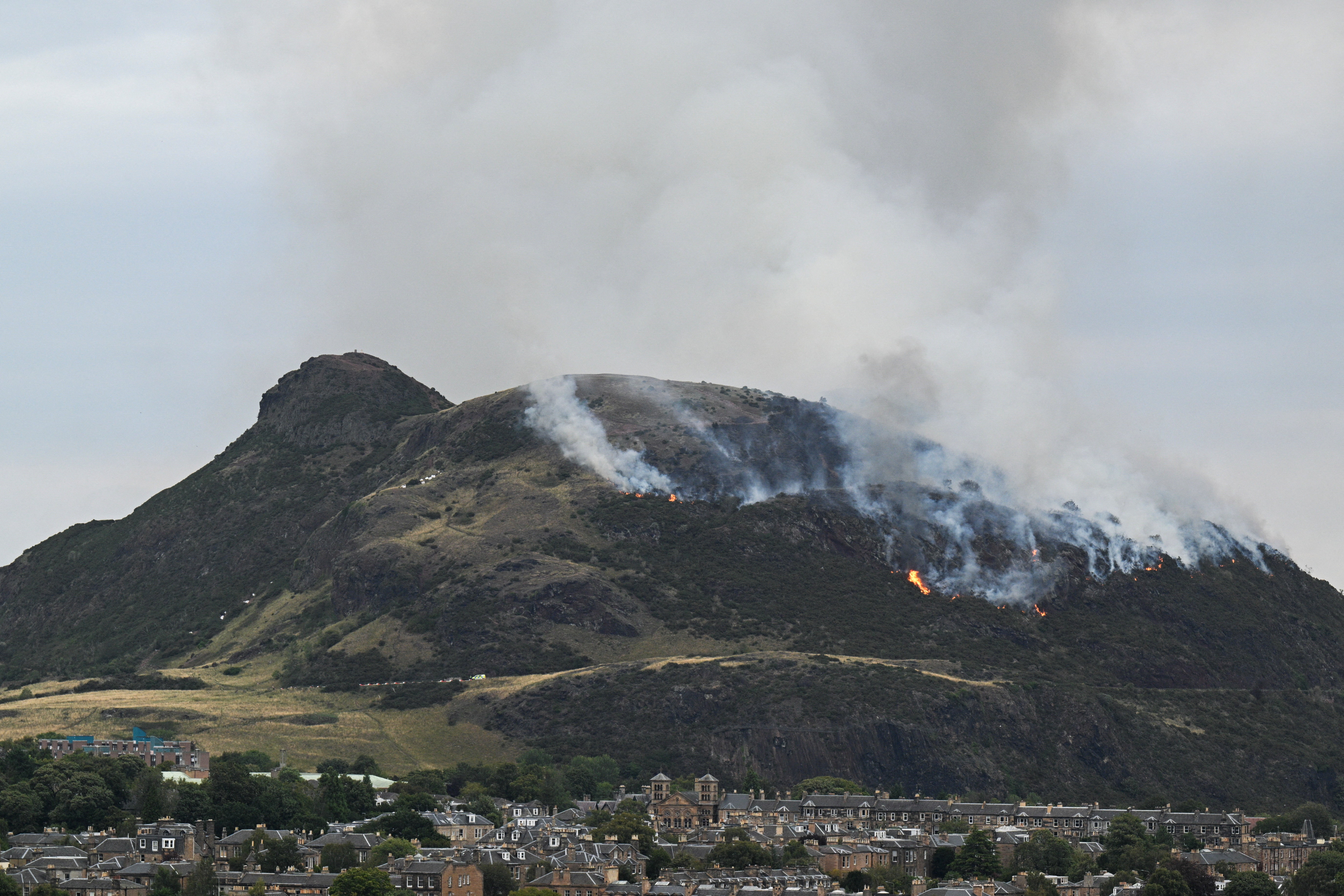An unexpected fire erupted on Arthur’s Seat, the renowned inactive volcano overlooking Edinburgh, releasing clouds of smoke into the horizon and capturing the focus of locals, visitors, and emergency services. The flames, seen from many areas of the city, started on what was initially a peaceful day in Scotland’s capital, swiftly raising alarm about the possible harm to the cherished natural feature and the well-being of people nearby.
Observadores indicaron haber visto llamas danzar por las laderas herbosas antes de que el fuego se extendiera a una parte más amplia de la colina. Las condiciones secas, resultado de varios días sin lluvia, se cree que ayudaron al rápido avance del incendio. Aunque Arthur’s Seat suele ser verde y exuberante durante la mayor parte del año, las sequías a finales del verano y principio del otoño pueden hacer que las áreas de pastizales y aulagas sean especialmente susceptibles a prenderse fuego.
Firefighters reached the location quickly, assembling teams from various stations throughout Edinburgh. The difficult landscape presented obstacles, limiting vehicle access and requiring rescuers to manually transport gear along twisting paths. Individuals who were strolling or trekking nearby were directed away from the hazardous area, with some being accompanied along the trails by rescue workers.
Arthur’s Seat, located in Holyrood Park, is a geological wonder as well as a central hub for culture and leisure in the city. Reaching a height of 251 meters (823 feet), it provides sweeping views of Edinburgh, the Firth of Forth, and the surrounding areas. Locals and travelers alike frequently hike to its peak, where they often stop to enjoy the wildflowers, birdlife, and extensive views of the city below. Witnessing flames consuming parts of the hill was, for many, a stark reminder of how rapidly natural areas can become endangered.
Authorities have not yet determined the cause of the fire, although they are examining the possibility that human involvement played a part. Open fires, thrown-away cigarettes, or not fully put out barbecues are frequent causes of fires in grassland areas. Officials have highlighted the chance of unintended ignition from shattered glass or other objects that can focus sunlight. At this point, intentional arson is regarded as less probable, but law enforcement has not dismissed the idea.
Social media was quickly flooded with images and videos of the fire, some taken from Princes Street and Calton Hill, others from residents’ flats or nearby roads. The footage showed thick smoke billowing upward, shifting in color from grey to a more ominous black as it intensified. Many users expressed shock and sadness, with some sharing personal memories of hiking Arthur’s Seat or visiting it as part of family traditions.
Municipal authorities have issued a reminder to residents that Holyrood Park, which encompasses Arthur’s Seat, is under the management of Historic Environment Scotland. This organization collaborates closely with emergency responders to safeguard both tourists and the natural surroundings. During the fire control operations, certain areas of the park were briefly shut down to stop spectators from disrupting the firefighting activities and to guarantee everyone’s safety.
Environmental experts warn that fires like this can have long-term ecological consequences. Although grasslands and heathland can regenerate, the loss of plant cover leaves soil exposed to erosion, and some species of flora and fauna may take years to recover. Certain nesting birds, small mammals, and insects could lose vital habitat if the burn area is extensive. Invasive plant species, which can thrive in disturbed soil, may also take hold, altering the natural balance of the park’s ecosystem.
The incident has also reignited discussions about fire prevention in public green spaces. Edinburgh City Council and park authorities have previously issued seasonal advisories about the risks of grass fires, particularly during dry weather. Measures such as clearer signage, increased ranger patrols, and public awareness campaigns are now likely to be revisited in the wake of the blaze.
For those living in Edinburgh, Arthur’s Seat means more than just beautiful views—it embodies a significant part of the city’s essence. The ancient volcanic formation of the hill has endured for millions of years, withstanding ice ages, industrial development, and numerous generations of human habitation. Witnessing it at risk from fire, even momentarily, evokes a shared worry that goes beyond daily urban existence.
Para la tarde noche, los equipos de bomberos lograron controlar gran parte del incendio, aunque en algunas zonas las brasas seguían ardiendo. Las autoridades indicaron que sería necesario realizar una vigilancia nocturna para asegurar que el fuego no resurja, especialmente si las condiciones del viento cambian. El olor a humo persistía en algunas partes de la ciudad, recordando los eventos del día y lo frágiles que pueden ser incluso los paisajes más emblemáticos.
As the investigation continues, many in Edinburgh are reflecting on their relationship with Arthur’s Seat—not just as a tourist destination or a scenic hike, but as a shared heritage site whose preservation depends on the care and respect of everyone who visits. While the hill will likely recover in time, the fire serves as a cautionary tale about the risks posed by complacency, particularly in an era of increasingly unpredictable weather patterns linked to climate change.
For now, the hope is that Arthur’s Seat will return to its familiar state—green slopes dotted with wildflowers, trails buzzing with walkers, and summit views uninterrupted by the haze of smoke. But the fire will remain etched in the memories of those who saw it, a stark image of nature’s vulnerability in the heart of Scotland’s capital.

